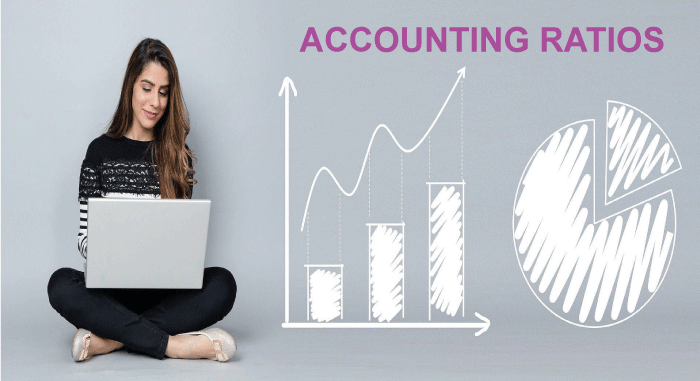Accounting RatioAre you curious about accounting ratios and their importance in financial analysis? Well, let me tell you a little secret. Even if numbers are not your thing, understanding accounting ratios is essential for assessing the financial health of any business. 
You don't need to be an expert in accounting to grasp the basics and gain insights into a company's short-term solvency, long-term profitability, effectiveness in managing assets and liabilities, and ability to meet its long-term obligations. In this blog post, we will explore more about accounting ratios. So, let's dive in and discover how accounting ratios can help you make informed investment decisions! What is Accounting Ratio?Accounting ratios are a type of financial ratio subset that includes a collection of essential metrics that help measure the profitability and efficiency of a company based on data from its financial reports. Simply put, these ratios help determine the relationship between different accounting data points. It would not be wrong to say that these ratios reflect the basis of ratio analysis. Types of Accounting RatiosAlthough there are many accounting ratios, and each helps in understanding the specific metrics of the company, discussed below are some of the common accounting ratios that are widely used in the field of accounting:
Liquidity RatioLiquidity ratios sound like a mouthful. Well, it's more complicated than it seems. Liquidity ratios measure a company's ability to pay off its short-term obligations. Think of it as a company's "breathing room" to cover expenses like salaries, bills, and other financial obligations. Two commonly used liquidity ratios are the current ratio and the quick ratio. 
Importance of Liquidity Ratio Liquidity ratios are crucial in assessing a company's short-term solvency. If a company cannot meet its short-term obligations, it may lead to bankruptcy or insolvency. Liquidity ratios provide insights into a company's ability to manage its cash flow and maintain its financial stability. As an investor or creditor, analyzing a company's liquidity ratios is crucial in making informed decisions about lending money, investing in stocks or bonds, or entering into business agreements. Profitability RatiosLet's talk about profitability ratios. These ratios measure a company's ability to generate profits over a specific period. After all, we all want to know if a company is profitable, right? Three commonly used profitability ratios are gross profit margin, net profit margin, and return on equity. 
Importance of Profitability Ratios Profitability ratios are essential in assessing a company's long-term profitability. A company that consistently generates profits is likely to have a positive outlook in the market. Profitability ratios provide insights into a company's pricing strategy, operating efficiency, and return on investment. As an investor, analyzing a company's profitability ratios is crucial in determining whether to invest in a company's stocks or bonds. Profitability ratios can also be useful for management in making informed decisions about expanding operations or cutting costs. Efficiency RatiosEfficiency ratios are all about how effectively a company manages its assets and liabilities to generate revenue. Let's break it down, shall we? Efficiency ratios measure how efficiently a company uses its resources to generate revenue. Three commonly used efficiency ratios are inventory turnover, accounts receivable turnover, and accounts payable turnover. 
Importance of Efficiency Ratios Efficiency ratios are essential in assessing a company's effectiveness in managing its assets and liabilities. A company that manages its resources well is likely to generate revenue more efficiently. Efficiency ratios provide insights into a company's inventory management, credit and collections policy, and payment management. As an investor, analyzing a company's efficiency ratios is crucial in making informed decisions about investing in a company's stocks or bonds. Efficiency ratios can also be useful for management in making informed decisions about improving operations, managing inventory, and enhancing the company's cash flow. Solvency RatiosSolvency ratios are a crucial tool for assessing a company's long-term financial stability. These ratios help us understand if a company has the ability to meet its long-term obligations. Two commonly used solvency ratios are the debt-to-equity ratio and the interest coverage ratio. 
Importance of Solvency Ratios Solvency ratios are important for assessing a company's ability to meet its long-term obligations. If a company cannot meet its long-term obligations, it may lead to insolvency or bankruptcy. Solvency ratios provide insights into a company's financial structure, risk management, and cash flow. As an investor or creditor, analyzing a company's solvency ratios is crucial in making informed decisions about investing in a company's stocks or bonds or lending money to the company. Solvency ratios can also be useful for management in making informed decisions about managing debt, improving cash flow, and maintaining the company's financial stability. Industry-Specific Accounting RatiosWhen evaluating a company's financial performance, it is important to consider industry-specific accounting ratios. Accounting ratios vary across different industries, as each industry has its unique characteristics and challenges. For example, a retail company would have different accounting ratios compared to a manufacturing company due to differences in their business models. Industry-specific accounting ratios can be used to gain insight into a company's financial performance and compare it to its peers within the same industry. By comparing a company's accounting ratios to industry benchmarks, investors and analysts can identify strengths and weaknesses in the company's financial performance and make informed investment decisions. Let's take a look at some examples of industry-specific accounting ratios:
Using Accounting Ratios for Benchmarking and ComparisonsAccounting ratios can be a useful tool for benchmarking and making comparisons between different companies, industries, and time periods. By comparing the financial ratios of one company to another or to industry averages, potential investors and analysts can gain valuable insights into a company's financial health and performance. One of the primary benefits of using accounting ratios for comparisons is that they can provide a quick and easy way to evaluate a company's financial performance. Accounting ratios can be calculated using readily available financial data, making it simple to compare different companies and industries. However, it's important to note that there are limitations to using accounting ratios for comparisons. For example, companies may use different accounting methods or have different business models, which can make it challenging to compare their financial ratios accurately. Additionally, accounting ratios only provide a snapshot of a company's financial performance and may not capture all of the nuances of its operations or industry. Despite these limitations, accounting ratios are still widely used for benchmarking and comparisons. For example, investors may compare the price-to-earnings ratio of one company to others in the same industry to identify undervalued stocks. Similarly, a company may use the debt-to-equity ratio to benchmark its financial leverage against industry averages. Accounting ratios can also be used for comparisons within a company over time. For example, a company may compare its current ratio from one year to the next to track its ability to meet short-term obligations. Similarly, a company may monitor its inventory turnover ratio over time to identify opportunities to optimize its inventory management practices. Limitations and Challenges of Accounting RatiosWhile accounting ratios can provide valuable insights into a company's financial health and performance, they also have limitations and challenges that should be taken into consideration when using them for analysis. One of the main limitations of accounting ratios is that they rely on historical financial data, which may not reflect a company's current or future operations. For example, if a company is in the midst of a major restructuring or expansion, its financial ratios may not accurately reflect its future financial performance. Additionally, accounting ratios can be impacted by accounting methods and assumptions, which can vary between companies and industries. This can make it difficult to compare financial ratios across different companies or to use ratios to make industry-wide comparisons. Another challenge of using accounting ratios is that they may only capture some of the nuances of a company's operations or industry. For example, some companies may have intangible assets, such as patents or trademarks, which are not reflected in traditional accounting ratios. Furthermore, accounting ratios should be used in conjunction with other financial analysis tools to provide a more comprehensive understanding of a company's financial performance. For example, cash flow analysis can help identify potential liquidity issues that may not be captured in traditional accounting ratios. Despite these limitations and challenges, accounting ratios can still provide valuable insights into a company's financial health and performance when used appropriately. It's important to consider these limitations and to use accounting ratios in conjunction with other financial analysis tools to gain a more comprehensive understanding of a company's financial performance. Accounting Ratios and Financial StatementsAccounting ratios are derived from financial statements, which are a company's official record of its financial activities and transactions. Financial statements include the income statement, balance sheet, and cash flow statement. Accounting ratios are then calculated based on the data presented in these financial statements. The relationship between financial statements and accounting ratios is that financial statements provide the raw data that is used to calculate accounting ratios. For example, the balance sheet provides information on a company's assets, liabilities, and equity, which is used to calculate solvency ratios. The income statement provides information on a company's revenue and expenses, which is used to calculate profitability ratios. Likewise, the cash flow statement provides information on a company's cash inflows and outflows, which is used to calculate liquidity ratios. Financial statement analysis can be used in conjunction with accounting ratios to evaluate a company's financial performance. By analyzing the financial statements, analysts can identify trends and patterns that may not be immediately apparent from the accounting ratios alone. For example, if a company's profitability ratios are declining, financial statement analysis can be used to identify the specific areas of the business that are contributing to the decline. The Bottom LineAccounting ratios are an essential tool for financial analysis and decision-making. They provide insights into a company's liquidity, solvency, profitability, and efficiency, which are crucial factors in evaluating its financial health. However, it's important to keep in mind that accounting ratios have their limitations and should be used in conjunction with other financial analysis tools to make informed decisions. As we strive towards a more financially literate society, understanding and interpreting accounting ratios can empower individuals to make better financial decisions for themselves and their businesses. Ultimately, it is not just about the numbers but also about the people and the impact that financial decisions have on their lives.
Next TopicAccounting Records
|
 For Videos Join Our Youtube Channel: Join Now
For Videos Join Our Youtube Channel: Join Now
Feedback
- Send your Feedback to [email protected]
Help Others, Please Share









